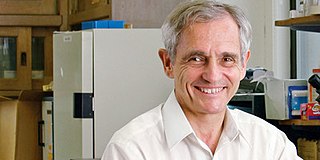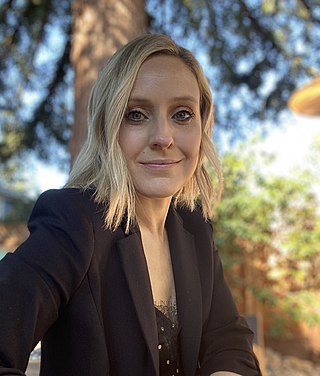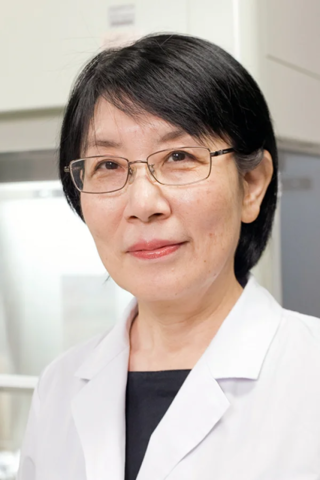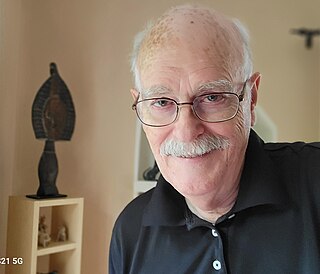Related Research Articles

The suprachiasmatic nucleus or nuclei (SCN) is a small region of the brain in the hypothalamus, situated directly above the optic chiasm. It is the principal circadian pacemaker in mammals, responsible for generating circadian rhythms. Reception of light inputs from photosensitive retinal ganglion cells allow it to coordinate the subordinate cellular clocks of the body and entrain to the environment. The neuronal and hormonal activities it generates regulate many different body functions in an approximately 24-hour cycle.

Vasoactive intestinal peptide, also known as vasoactive intestinal polypeptide or VIP, is a peptide hormone that is vasoactive in the intestine. VIP is a peptide of 28 amino acid residues that belongs to a glucagon/secretin superfamily, the ligand of class II G protein–coupled receptors. VIP is produced in many tissues of vertebrates including the gut, pancreas, cortex, and suprachiasmatic nuclei of the hypothalamus in the brain. VIP stimulates contractility in the heart, causes vasodilation, increases glycogenolysis, lowers arterial blood pressure and relaxes the smooth muscle of trachea, stomach and gallbladder. In humans, the vasoactive intestinal peptide is encoded by the VIP gene.

Stephen Marc Breedlove is the Barnett Rosenberg professor of Neuroscience at Michigan State University in East Lansing, Michigan. He was born and raised in the Ozarks of southwestern Missouri. After graduating from Central High School in 1972, he earned a bachelor's degree in Psychology from Yale University in 1976, and a Ph.D. in psychology from UCLA in 1982. He was a professor of psychology at the University of California, Berkeley from 1982 to 2003, moving to Michigan State in 2001. He works in the fields of Behavioral Neuroscience and Neuroendocrinology. He is a member of the Society for Neuroscience and the Society for Behavioral Neuroendocrinology, and a fellow of the Association for Psychological Science (APS) and the Biological Sciences section of the American Association for the Advancement of Science (AAAS).

C. Sue Carter is an American biologist and behavioral neurobiologist. She is an internationally recognized expert in behavioral neuroendocrinology. In 2014 she was appointed Director of The Kinsey Institute and Rudy Professor of Biology at Indiana University. Carter was the first person to identify the physiological mechanisms responsible for social monogamy.
Michael Menaker, was an American chronobiologist who was Commonwealth Professor of Biology at University of Virginia. His research focused on circadian rhythmicity of vertebrates, including contributing to an understanding of light input pathways on extra-retinal photoreceptors of non-mammalian vertebrates, discovering a mammalian mutation for circadian rhythmicity, and locating a circadian oscillator in the pineal gland of bird. He wrote almost 200 scientific publications.

Frances A. Champagne is a Canadian psychologist and University Professor of Psychology at the University of Texas at Austin known for her research in the fields of molecular neuroscience, maternal behavior, and epigenetics. Research in the Champagne lab explores the developmental plasticity that occurs in response to environmental experiences. She is known for her work on the epigenetic transmission of maternal behavior. Frances Champagne's research has revealed how natural variations in maternal behavior can shape the behavioral development of offspring through epigenetic changes in gene expression in a brain region specific manner. She won the NIH Director's New Innovator Award in 2007 and the Frank A. Beach Young Investigator Award in Behavioral Neuroendocrinology in 2009. She has been described as the "bee's knees of neuroscience". She serves on the Committee on Fostering Healthy Mental, Emotional, and Behavioral Development Among Children and Youth in the United States.

William Joseph Schwartz is an American neurologist and scientist who serves as Professor and Associate Chair for Research and Education in the neurology department at the University of Texas Dell Medical School. His work on the neurobiology of circadian timekeeping has focused on the mammalian suprachiasmatic nucleus. Schwartz demonstrated that the suprachiasmatic nucleus is rhythmic in vivo using a 2-deoxyglucose radioactive marker for functional brain imaging. As of 2014, he is editor of the Journal of Biological Rhythms.

Donald Wells Pfaff is a professor and head of the Laboratory of Neuroscience and Behavior at The Rockefeller University in New York City.
Elizabeth Adkins-Regan is an American comparative behavioral neuroendocrinologist best known for her research on the hormonal and neural mechanisms of reproductive behavior and sexual differentiation in birds. She is currently a professor emeritus in the Department of Psychology and the Department of Neurobiology and Behavior at Cornell University.

Michael Harvey Hastings is a British neuroscientist who works at the Medical Research Council MRC Laboratory of Molecular Biology (LMB) in Cambridge, UK. Hastings is known for his contributions to the current understanding of biological clocks in mammals and marine invertebrates.
Judy Shih-Hwa Liu is the Sidney A. Fox and Dorothea Doctors Fox Professor of Ophthalmology and Neuroscience at Brown University. She works on the cortical malformations that cause epilepsy.
Emilie Rissman is an American professor in the Biological Sciences department at North Carolina State University.

Erin M. Gibson is a glial and circadian biologist as well as an assistant professor in the Department of Psychiatry and Behavioral Sciences and the Stanford Center for Sleep Sciences and Medicine at Stanford University. Gibson investigates the role of glial cells in sculpting neural circuits and mechanistically probes how the circadian rhythm modulates glial biology.
Randy J. Nelson is an American neuroscientist who holds the Hazel Ruby McQuain Chair for Neurological Research and the founding chair of the Department of Neuroscience at the West Virginia University School of Medicine. Much of his research has focused on the contribution of circadian and seasonal rhythms on physiology and behavior.
Liisa Ann Margaret Galea is a Canadian neuroscientist who is a professor of psychology at the University of British Columbia. She is a member of the Centre for Brain Health and Director of the Graduate Programme in Neuroscience. Her research considers the impact of hormones on brain health and behaviour.

Sato Honma is a Japanese chronobiologist who researches the biological mechanisms of circadian rhythms. She mainly collaborates with Ken-Ichi Honma on publications, and both of their primary research focuses are the human circadian clock under temporal isolation and the mammalian suprachiasmatic nucleus (SCN), its components, and associates. Honma is a retired professor at the Hokkaido University School of Medicine in Sapporo, Japan. She received her Ph.D. in physiology from Hokkaido University. She taught physiology at the School of Medicine and then at the Research and Education Center for Brain Science at Hokkaido University. She is currently the director at the Center for Sleep and Circadian Rhythm Disorders at Sapporo Hanazono Hospital and works as a somnologist.
Johanna H. Meijer is a Dutch scientist who has contributed significantly to the field of chronobiology. Meijer has made notable contributions to the understanding of the neural and molecular mechanisms of circadian pacemakers. She is known for her extensive studies of photic and non-photic effects on the mammalian circadian clocks. Notably, Meijer is the 2016 recipient of the Aschoff and Honma Prize, one of the most prestigious international prizes in the circadian research field. In addition to still unraveling neuronal mechanisms of circadian clocks and their applications to health, Meijer's lab now studies the effects of modern lifestyles on our circadian rhythm and bodily functions.
Martha Ulbrick Gillette is a chronobiologist and neurobiologist with research focusing on the effects of circadian clocks on integrative brain functions metabolism and the molecular mechanisms involved in signaling pathways. She is a fellow of the American Association for the Advancement of Science.

Arthur Palmer Arnold is an American biologist who specializes in sex differences in physiology and disease, genetics, neuroendocrinology, and behavior. He is Distinguished Professor of Integrative Biology & Physiology at the University of California, Los Angeles (UCLA). His research has included the discovery of large structural sex differences in the central nervous system, and he studies of how gonadal hormones and sex chromosome genes cause sex differences in numerous tissues. His research program has suggested revisions to concepts of mammalian sexual differentiation and forms a foundation for understanding sex difference in disease. Arnold was born in Philadelphia.
Martin R. Ralph is a circadian biologist who serves as a professor in the Psychology Department at the University of Toronto. His research primarily focuses on circadian rhythmicity in the fields of neuroscience, psychology, and endocrinology. His most notable work was has been on the suprachiasmatic nucleus, now recognized as the central circadian pacemaker in mammals, but has also investigated circadian rhythms in the context of time, memory, and light.
References
- ↑ "Rae Silver | Barnard Psychology". psychology.barnard.edu. Retrieved 2020-01-30.
- 1 2 3 4 5 6 7 8 9 10 11 12 "Rae Silver C.V." (PDF).
- 1 2 3 4 5 6 7 8 Helmreich, Dana L. (9 December 2019). "Profiles of women in science: Rae Silver, Neuroscience Program and Psychology at Barnard College, and Department of Psychology at Columbia University, New York, NY USA". European Journal of Neuroscience. 52 (5): 3290–3294. doi: 10.1111/ejn.14604 . PMID 31648404.
- ↑ "Presidents of the SBN".
- 1 2 "Daniel S. Lehrman Lifetime Achievement Award in Behavioral Neuroendocrinology".
- ↑ "Editorial Board | eNeuro". www.eneuro.org. Retrieved 2020-03-07.
- ↑ "European Journal of Neuroscience". Wiley Online Library. Retrieved 2020-03-07.
- ↑ Lehman, Michael N.; Silver, Rae; Gladstone, W. R.; Kahn, Robert M.; Gibson, Marie; Bittman, Eric L. (1 June 1987). "Circadian rhythmicity restored by neural transplant. Immunocytochemical characterization of the graft and its integration with the host brain". The Journal of Neuroscience. 7 (6): 1626–1638. doi: 10.1523/JNEUROSCI.07-06-01626.1987 . PMC 6568867 . PMID 3598638. S2CID 15364778.
- ↑ Silver, Rae; LeSauter, Joseph; Tresco, Patrick A.; Lehman, Michael N. (August 1996). "A diffusible coupling signal from the transplanted suprachiasmatic nucleus controlling circadian locomotor rhythms". Nature. 382 (6594): 810–813. Bibcode:1996Natur.382..810S. doi:10.1038/382810a0. PMID 8752274. S2CID 4364531.
- ↑ "Society for Research on Biological Rhythms 2018 Award Winner List" (PDF).
- ↑ "Rae Silver". American Academy of Arts & Sciences. Retrieved 2020-01-30.
- ↑ "Antman, Klein, Prince, Silver Are Elected Fellows of AAAS. Columbia University Record, November 14, 1997". www.columbia.edu. Retrieved 2020-01-30.
- ↑ Christina Ricci , retrieved 2020-01-30
- ↑ "Mannequin III - The Daily Show with Jon Stewart (Video Clip)". Comedy Central. 16 November 1999. Retrieved 2020-01-30.
- ↑ Busting through the "Women's Entrance" | Rae Silver | TEDxBarnardCollege , retrieved 2020-01-30
- ↑ Baran, Nicole M. (2018-08-16). "How Women Came to Dominate Neuroendocrinology". Nautilus. Retrieved 2020-01-30.
This article needs additional or more specific categories .(April 2021) |